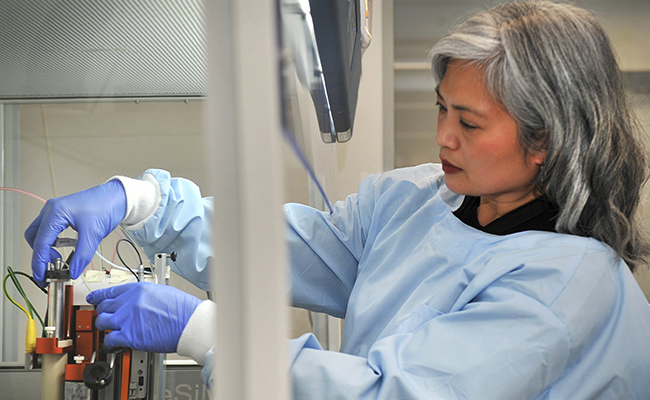
Associate Professor Jaydee Cabral hopes her research in 3D bioprinted vasculature supports advancements towards bioprinting of vital organs. Photo credit: Christine O'Connor, ODT.
Innovative Otago research could help reconstruct breast tissue that cancer patients have lost during treatment.
Associate Professor Jaydee Cabral from the Department of Microbiology and Immunology is developing 3D-printed nipple areolar complexes for breast cancer patients.
3D bioprinting uses a bioprinter to create a gel-based cell-friendly environment to act as a scaffold system for cells, so the cells can grow into more complex living structures, she explains.
“We use water-loving polymers that are soft enough to extrude in the 3D printing process which we then set into a more rigid form using UV light”.
Her laboratory houses a GeSIM 3.1 Bioscaffolder, the only bioprinter of its kind in New Zealand.
A recipient of the Royal Society of New Zealand's Catalyst Seed Fund, she says, "this research is important because there is currently nothing clinically available to replace the nipple area that can be lost during a mastectomy”.
Her research specialises in creating 3D bioprinted vasculature, or blood vessels. This thicker kind of tissue is harder to create than thinner tissue because of the risk of low oxygen levels and nutrients that could cause the tissue to die.
Associate Professor Cabral hopes that solving the vascularisation problem for thicker tissue will lead to advancements in the field, which could one day include 3D bioprinting of vital organs.
The areolar project is in collaboration with Professor John Fisher, Department Chair of Bioengineering at the University of Maryland, where she will visit in June. She is also excited to learn more about the BioAssemblyBot at Maryland, which goes one step further, by printing with a 6-axis robotic arm to create more complex tissue structures.
“My research resides at the interface of chemistry, microbiology, and bioengineering with the goal of developing novel medical devices for various biomedical applications and I would love to bring students into this global phenomenon,” she says.
“For students undertaking Health Sciences First Year, I would love for them to know that there are so many opportunities to make a massive and enduring contribution through research and innovation.”
Associate Professor Cabral is keen to attract postgraduate students to the “innovative and interesting” areola project in particular.
As a Filipina and a woman, she is proud to be a visible role model for aspiring researchers from minority backgrounds, saying that “you can't be it, if you don't see it!”.
Find out more about the Bioengineering Postgraduate Programme.
